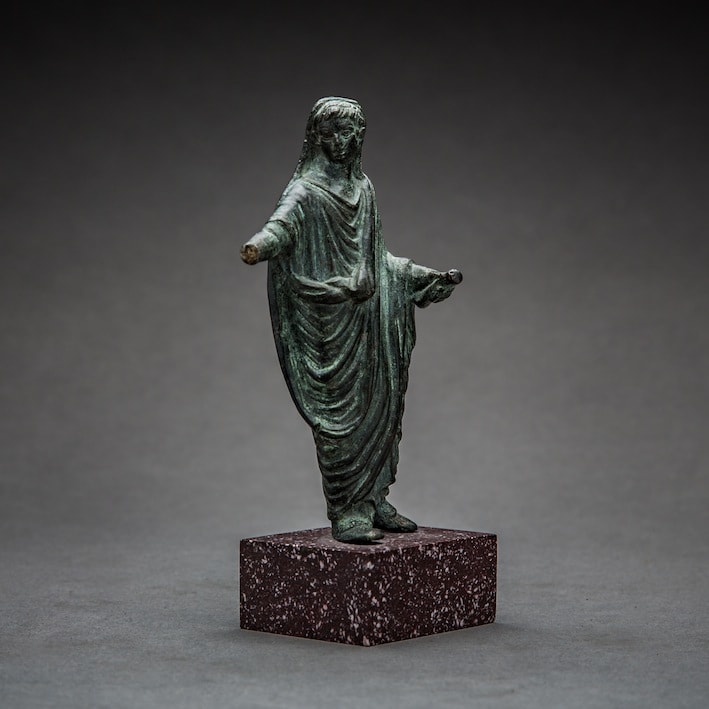Roman Bronze Sculpture of Augustus as a Priest, 1 Century BCE - 1st Century CE
Bronze
11.8 x 6.4 cm
4 5/8 x 2 1/2 in
4 5/8 x 2 1/2 in
LO.1325
Further images
Octavian Caesar, or as he is better known, Augustus, is one of the most recognizable and best-loved figures of history. With his great respect for art and his patient diligence...
Octavian Caesar, or as he is better known, Augustus, is one of the most recognizable and best-loved figures of history. With his great respect for art and his patient diligence in government, this ruler was able to raise a republic fraught with tension and civil disorder to the empire that would shape all of European history. So loved was Augustus as father of the Roman world, that upon his death he was deified. Most surviving depictions of Augustus portray him in the later phases of life, as the dignified sage that he was in his late sixties and early seventies. But Augustus did not rise to power due to the majestic wisdom that is so often associated with him and the years of his long and fruitful reign. Rather, it was the fierce intelligence, confident and warrior-like strength, and moderated energy that this portrait exudes. Augustus defeated Marc-Antony and became master of the Roman world at age 33, and immediately set about redefining the Roman way of life. It is easy to imagine these olive-shaped eyes, so clear and vigorous under the firm brow, poring over his architect’s plans for new temples and aqueducts, or penetrating the obsequious mask of a courier or diplomat. It is easy to imagine his mouth, so regal and shapely, pouring forth rhetoric- soldiers leaping to his lip’s command, senators swayed by their enticement, artists stirred by their praise. For classical enthusiasts, and anyone who is exhilarated by being in the presence of giants, this piece has an unusual hold. It does not show us a conqueror as we usually see them. Rather than basking in the aftermath of his success, being sculpted in the light of posterity- this piece shows us the God when he was still mortal. Octavian’s ambition, his potential, and his zeal are forever immortalized in this masterwork. For those of us who have yet to reach Olympus, yet are certain that a throne lies in wait for us, this piece is a reminder of the common origin of all geniuses, giants, and prodigies. We see, in the tension of our young Augustus, a reflection of our own ability and our own potential- and for this, just as much as for its aesthetic perfection, we value this piece as an undeniable product of artistic brilliance. This stunning marble portrait of Caesar Augustus shows his valiant and powerful place in history. As the heir to Julius Caesar, Augustus faced the enormous task of reorganizing the Roman Empire. Though there were many trials, Augustus managed to gain ultimate power. By the age of 33, Augustus was master of the entire roman world. Augustus was a brilliant commander and wise ruler. He used the art of portraiture to communicate his image to his subjects and neighbors with the intent to illustrate his discerning might and unparalleled power unseen since the time of Alexander the great.
70
of
70





